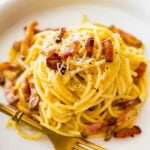Authentic Carbonara Recipe
This traditional Carbonara Recipe (without cream) is an easy 20 minute restaurant worthy meal you can make on a weeknight! This recipe is perfectly smooth and creamy without using cream. In Italy, a traditional carbonara means no cream. Learn to make it the authentic way.
Servings: 6 servings
Ingredients
- 4 eggs room temperature
- 2 cups freshly grated Parmigiano or Pecorino Romano cheese or a mix or both
- Coarsely ground black pepper
- 1 lb guanciale pancetta, or bacon, sliced into pieces about 1/4 inch thick by 1/3 inch square, 16 oz
- 1 lb pasta of choice
Instructions
Bring the water to a boil
- Fill a large pot with water and bring to a rolling boil. Season generously with salt—about 2 tablespoons per 500 g of pasta. It should taste like the sea.
Prepare the egg and cheese mixture
- In a medium bowl, whisk the eggs until smooth. Stir in the grated Pecorino Romano and a generous amount of freshly cracked black pepper. You should have a thick, cohesive paste. Set aside.
Cook the guanciale
- Place the guanciale in a cold skillet (no oil needed) and turn the heat to medium. Let the fat slowly render and the guanciale become golden and crisp at the edges, about 5–7 minutes. Do not over-crisp it—it should be tender with a bit of bite. Remove from heat. Using a slotted spoon, transfer guanciale to a plate. Leave about 2 tablespoons of rendered fat in the pan.
Cook the pasta
- Add pasta to the boiling water and cook until al dente, according to package instructions. Reserve 1/2 cup of pasta water before draining.
Combine and emulsify
- Transfer the drained pasta directly into the warm pan with the guanciale fat. Toss to coat the pasta evenly. Remove pan from heat completely (this prevents scrambling the eggs).
- Slowly pour in the egg and cheese mixture, tossing vigorously with tongs or stirring quickly to create a silky sauce. Add a splash or two of the reserved pasta water, as needed, to loosen and emulsify the sauce. It should cling to the pasta and look glossy, never dry or soupy.
Finish and serve
- Fold in the cooked guanciale, saving a few pieces for garnish. Plate immediately and finish with more Pecorino Romano and a good grind of black pepper.
Notes
- If possible, use guanciale, not pancetta or bacon. Guanciale (cured pork cheek) has a richer, more delicate flavor and higher fat content that's perfect for an authentic carbonara.
- Eggs at room temperature. They mix more smoothly and prevent shocking the sauce when added to the pasta.
- Remove pan from heat before adding eggs. The residual warmth is enough to create a silky sauce without scrambling.
- Toss vigorously. This is how you make the sauce glossy and emulsified. Stirring quickly with tongs mimics the motion of a whisk.
- Reserve pasta water. A little goes a long way to loosen the sauce and help it coat the noodles.
- Freshly cracked black pepper. It’s not just seasoning—it’s a key flavor in carbonara, so don’t be shy.
- Serve immediately. Carbonara waits for no one. The sauce is at its best right after it comes together. Buon appetito!
Nutrition
Calories: 737kcal | Carbohydrates: 59g | Protein: 33g | Fat: 40g | Saturated Fat: 16g | Polyunsaturated Fat: 5g | Monounsaturated Fat: 16g | Trans Fat: 0.1g | Cholesterol: 73mg | Sodium: 1072mg | Potassium: 382mg | Fiber: 2g | Sugar: 2g | Vitamin A: 288IU | Calcium: 416mg | Iron: 2mg
